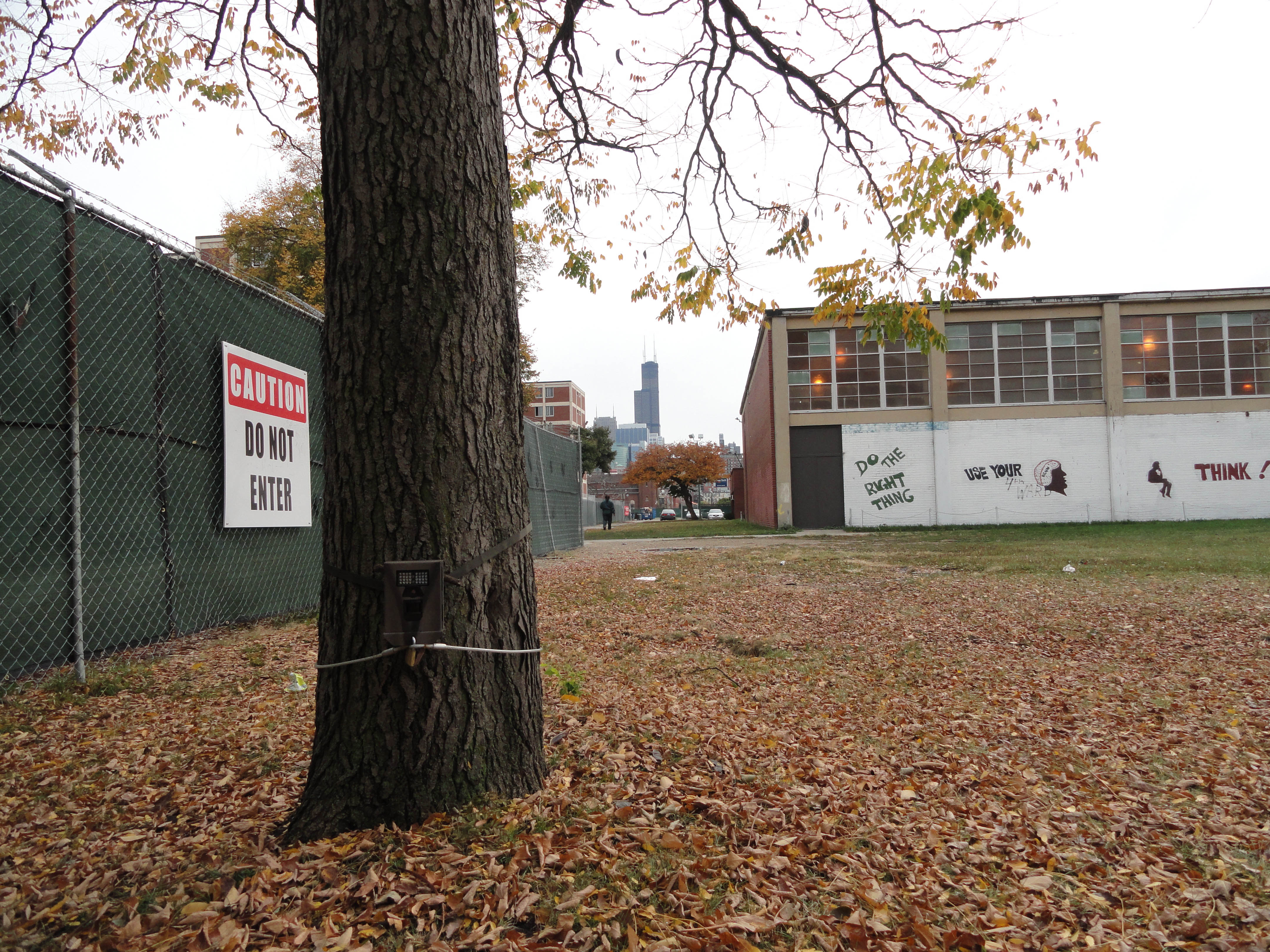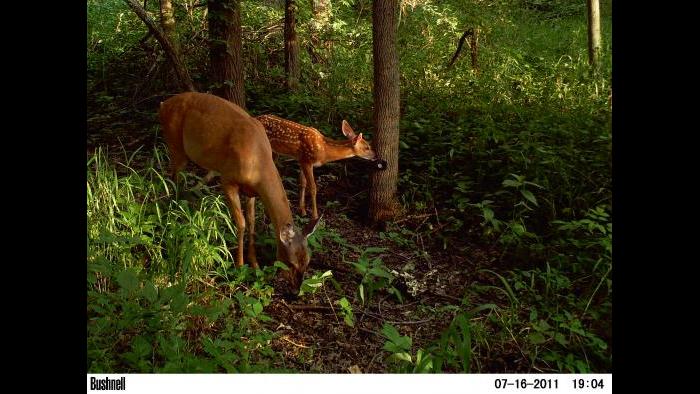Chicago Wildlife Watch explores wildlife that utilize public spaces such as these coyotes foraging in a park on the Northwest Side of Chicago. (Courtesy of Urban Wildlife Institute/Lincoln Park Zoo)
What do you do with a mountain of scientific data that’s sitting around waiting to be processed? In today’s world of 24-hour connectivity, you enlist the help of the Internet. That’s one of the ideas behind Chicago Wildlife Watch, a crowd-sourcing project that lets anyone with a connected device help local researchers with a massive science project on Chicago’s urban ecosystem.
Scientists are trying to answer questions about where our wild neighbors go, which species are most common and which may be in decline, how they compete with one another, and how humans impact their choices. The story is told with the help of camera traps, small motion-triggered devices set up four times a year at more than 100 locations across the city and suburbs.
"What we're trying to do is figure out how urban animals make decisions, that's sort of the holy grail for me,” said Seth Magle, Ph.D., Director of the Urban Wildlife Institute, a research division of the Lincoln Park Zoo that looks at interactions between people and wildlife. “If we could understand what causes them to move around the landscape in a certain way, how they select habitat, how they live, then we can actually start to design smarter cities. How we can design cities that can be a home to wildlife and to people without creating human-wildlife conflict."
Here’s how it works: Users go to the site, click “Get started” and then look at photos of animals captured by the cameras. Buttons prompt users to select what type of animal is in an image – “deer,” “muskrat” and “fox,” for example – before moving on to the next capture. Each camera snaps photos for a month during seasonal setups, and, as anyone who owns a digital camera or smartphone can imagine, the photos pile up quickly.
About 900,000 were loaded into the site in September 2014. It’s taken roughly a year to get to the halfway point with more than 5,500 active users pitching in. All the while, more photos are being collected.
“No one has ever collected this much data on urban wildlife before,” said Magle. “It's really an unprecedented kind of a study, and that's why we need so much help.”
 Seth Magle, Ph.D., Director of the Urban Wildlife Institute, secures a camera trap that is used to capture data for Chicago Wildlife Watch. (Courtesy of Urban Wildlife Institute/Lincoln Park Zoo)
Seth Magle, Ph.D., Director of the Urban Wildlife Institute, secures a camera trap that is used to capture data for Chicago Wildlife Watch. (Courtesy of Urban Wildlife Institute/Lincoln Park Zoo)
Welcome to the Zooniverse
Partnering on Chicago Wildlife Watch with Magle's group at the Lincoln Park Zoo is Adler Planetarium’s Zooniverse team, a citizen-science project developed with the University of Oxford that runs dozens of projects around the globe.
Billed as "the largest online platform for collaborative volunteer research,” the Zooniverse has a massive reach. Volunteers around the world can annotate WWI soldiers’ diaries, identify and organize sunspots, and analyze cancer data, among other projects. You can even use historic ship logs to help with climate model projections. All from your desk, couch or CTA seat.
Magle says that the Zooniverse team, which has a local office at Adler, was interested in doing research in Chicago. He wrote up a proposal, outlined his ideas, and they agreed to take on the project.
Changing the way we think about wildlife
Citizen involvement in Chicago Wildlife Watch meets more than a practical need. While the public genuinely contributes to the process of classifying data, there's a strong educational component at work. Getting the community involved in wildlife research helps shift the way we think about our relationship with animals, Magle said, and helps educate the public about urban species.
“We live on a planet that gets more and more urban every year,” said Magle. “Increasingly, I think we need to change the way we think about wildlife – not just as a species that lives out in some protected area that most people will never see – but something that all of us live with, and that can be a wonderful thing, once you've done the science to see how it is that they behave in cities and how best you can coexist with them."
This type of people-powered research, as it’s called, isn’t reserved for the science-minded, so you don’t need to worry about misidentifying a mink or overlooking an opossum while clicking around the Chicago Wildlife Watch website. The system was built with amateurs in mind, Magle contends. He points to the fact that the system uses guides and descriptions in addition to photos to help with some classifications that can be more tricky. For example, when there is only part of an animal visible in an image, such as a tail.
“Don't feel deterred by a lack of experience,” he said. “It's something that anyone can contribute to very quickly. It doesn’t take a lot of time either. If you have three minutes while you're waiting for a train you can help contribute to our research. I really want to make sure that anyone who wants to be involved in this can be."
 A Chicago Wildlife Watch camera trap in the South Loop. (Courtesy of Urban Wildlife Institute/Lincoln Park Zoo)
A Chicago Wildlife Watch camera trap in the South Loop. (Courtesy of Urban Wildlife Institute/Lincoln Park Zoo)
Quality control
The algorithm that powers the classification system, developed by the Zooniverse team, helps to prevent false identifications. It's a simple idea: The system looks for user agreement before an animal classification is recorded. That is, multiple people review the same image until the algorithm identifies the appropriate level of agreement.
"Since we're using these data for science, we need to be very confident that we're getting the correct answers about what animals are in these photos,” said Magle. As it turns out, the public is pretty good at this. "The good news is that our users do tend to agree. We find that about 98 percent agree on what's in the photo, so it does seem like our users are doing a great job."
And while users are working through the photos more quickly than a science team could, Magle would love to see the number of classifications increase from the current number of about 4,000 per day to 10,000 per day.
“My dream is that one day we'll be caught up so we're at a place where we're in real time, which is very exciting,” said Magle. “Cities change fast, and wildlife change quickly too. In order to understand how these patterns change over time, and what we can do to learn how to conserve and manage these species better, it would really be great if we could get caught up.”
 Deer get into view of a Chicago Wildlife Watch camera trap. (Courtesy of Urban Wildlife Institute/Lincoln Park Zoo)
Deer get into view of a Chicago Wildlife Watch camera trap. (Courtesy of Urban Wildlife Institute/Lincoln Park Zoo)
Human-wildlife conflict
When we see wildlife in our neighborhoods and communities, annoyance and even fear are common reactions to things like rabbits snacking on vegetable gardens, and coyotes threatening pets. But traffic is also a massive hazard, said Magle. “There's a lot more we could do to think about how animals move around the landscape, how they cross roads.” Disease is another area for research, as urban wildlife often live in higher densities, which can drive up rates of illness.
A lot of human interaction with wildlife is steeped in good intention, said Magle, but the best thing to do when you see wildlife? Nothing.
"Most of the time those animals are just fine. They're just doing their natural thing, just living their lives,” Magle said.
He suggests snapping a picture of the animal and putting it on Facebook to increase awareness of its presence in the city. In the case of sick animals or those in hazardous situations, the best thing to do is call Animal Control. But still, Magle said, “ninety percent of the time, the solution is to not interfere with those animals. It's better – even in cities – if they stay away from people."
To help now with the project, go to Chicago Wildlife Watch. You can find more Zooniverse projects, including those mentioned above, by going here.














